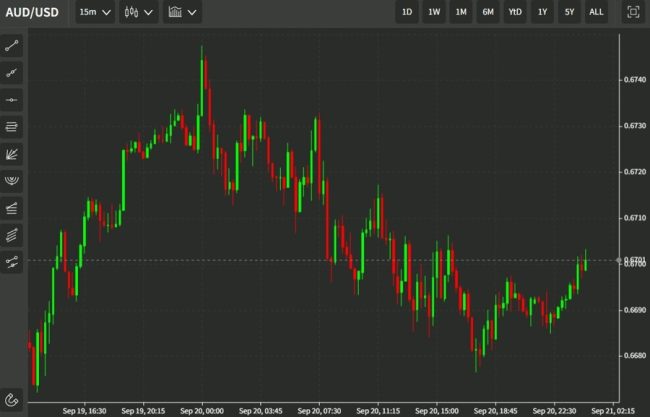The indicator is barely changed.
Westpac make the following points:
- The six-month annualised growth rate in the Westpac-Melbourne Institute Leading Index, which indicates the likely pace of economic activity relative to trend three to nine months into the future, fell to -0.36% in August, down from +0.49% in July
- Growth rate drops to –0.36%, a below trend pace.
- Weakest print since delta lockdown.
- Key drivers of slowdown: rising interest rates and falling commodity prices.
- Other factors: slowing in hours worked and US industrial production.
–
AUD/USD is not doing much. FX markets are awaiting the Federal Open Market Committee (FOMC) later on Wednesday.
aud
AUD
The Australian dollar (AUD) is the official currency of Australia, which is also used in Christmas Island, Cocos (Keeling) Islands, Norfolk Island, as well as independent pacific states.Introduced in 1966, the AUD is currently the fifth most traded currency in the world, behind only the US dollar, euro, Japanese yen, and British pound.The currency is very important to forex markets and is routinely used as a carry trade against other majors.The Reserve Bank of Australia (RBA) is the central banking authority tasked with the management and issuance of AUD banknotes.What Factors Affect the AUD?The AUD is more susceptible than other currencies to macroeconomic factors. Overall, monetary policy is the largest mover of the currency, including interest rate differentials.Beyond Australia, commodity prices such as those of precious metals and others are also important to the AUD and can cause fluctuations in its value relative to other currencies.Global risk sentiment and confidence are also indicators that are closely tracked given their correlation to the AUD.This is due to the AUD being seen as a commodity currency, and also used as one of the most popular growth and risk proxies in global financial markets.Any positive mood in the global market will likely cause the AUD to climb, while if there is a prevailing pessimism, the AUD will often decline.On a domestic scale, government credit ratings can also impact the AUD. Australia’s credit rating influences the risk profile of its debt.This trend directly influences the cost the government has to pay on the debt it owes.
The Australian dollar (AUD) is the official currency of Australia, which is also used in Christmas Island, Cocos (Keeling) Islands, Norfolk Island, as well as independent pacific states.Introduced in 1966, the AUD is currently the fifth most traded currency in the world, behind only the US dollar, euro, Japanese yen, and British pound.The currency is very important to forex markets and is routinely used as a carry trade against other majors.The Reserve Bank of Australia (RBA) is the central banking authority tasked with the management and issuance of AUD banknotes.What Factors Affect the AUD?The AUD is more susceptible than other currencies to macroeconomic factors. Overall, monetary policy is the largest mover of the currency, including interest rate differentials.Beyond Australia, commodity prices such as those of precious metals and others are also important to the AUD and can cause fluctuations in its value relative to other currencies.Global risk sentiment and confidence are also indicators that are closely tracked given their correlation to the AUD.This is due to the AUD being seen as a commodity currency, and also used as one of the most popular growth and risk proxies in global financial markets.Any positive mood in the global market will likely cause the AUD to climb, while if there is a prevailing pessimism, the AUD will often decline.On a domestic scale, government credit ratings can also impact the AUD. Australia’s credit rating influences the risk profile of its debt.This trend directly influences the cost the government has to pay on the debt it owes.
Read this Term
www.forexlive.com
